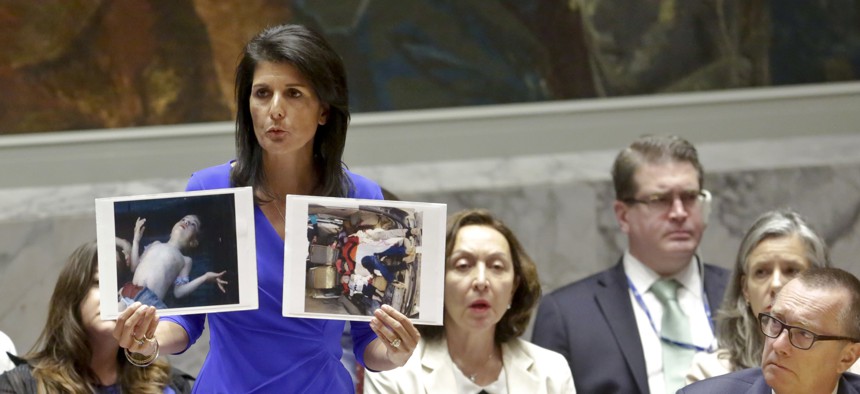
Nikki Haley, United States' Ambassador United Nations, shows pictures of Syrian victims of chemical attacks as she addresses a meeting of the Security Council on Syria at U.N. headquarters, Wednesday, April 5, 2017 AP / BEBETO MATHEWS
The Sarin Gas Attack In Syria Ignited an Information Battle
Victims quickly took to social media to distribute evidence of the use of chemical weapons.
The first response to the April 4 gas attack in Syria wasn’t bombs; it was bits.
Within hours of the attack, doctors, reporters, and medical volunteers took to Twitter, YouTube, and other outlets to tell the world that the Bashar al-Assad government had staged a monstrous attack with a toxic nerve agent that killed more than 80 people, including perhaps 30 children.
Medical workers near Khan Al Shekhoun announced the sarin-gas attack on Twitter. Witnesses reported that a Russian-made Sukhoi- 22 fired four rockets near Khan Al Shekhoun.
The next day, open-source news collective Bellingcat assembled a post , headlined “ The Khan Sheikhoun Chemical Attack, The Evidence So Far . ”
Video footage from media outlets told the same story more graphically.
Without knowing it, these witnesses were raising defenses against the follow-up move by the Assad regime and its ally Russia: denying the allegations. First the Assad regime issued its denial. Then Russia claimed that the aircraft strike hit a warehouse where terrorists were harboring chemical weapons. The Russian Defense Ministry wrote a Facebook post to that effect: “According to the objective monitoring data, yesterday, from 11:30 a.m. to 12:30 p.m. (local time) the Syrian aviation made a strike on a large terrorist ammunition depot and a concentration of military hardware in the eastern outskirts of the Khan Sheikhun town. On the territory of the depot, there were workshops, which produced chemical warfare munitions.Terrorists had been transporting chemical munitions from this largest arsenal to the territory of Iraq. Both international organizations and the authorities of the country had repeatedly proved their usage by terrorists.” Pro-Russian Twitter accounts of dubious origin quickly took up the cue and began posting into the space. U.S. alt-right Twitter accounts and outlets carried the trend further using the #syriahoax hastag.
But armed with the eyewitness accounts from the victims and their helpers, media and groups outside Syria worked to counter the Assad narrative. Human Rights Watch, New York Times reporter Gary Marcus , U.S. ambassador to the U.N. Niki Haley and other observers from around the world called the Russian story false.
On Thursday, the Turkish Health Ministry announced that they had conducted autopsies on three victims from the attack. The conclusion confirmed what many suspected and what people on the ground were telling reporters , that the Assad regime had deployed sarin against civilians.
A March U.N. report also concluded the Assad regime was making a habit of using chemical weapons in the conflict, in spite of similar Russian denials.
Following the U.S. Tomahawk strikes on Thursday, the question becomes whether Russia will make good on its threat to use its S-300 anti-aircraft radar and missile system to attack coalition aircraft targeting Assad airfields and runways.
Events over the days and weeks ahead will answer that question
All jokes aside, #Russia will take every defensive measure necessary to protect its personnel stationed in #Syria from terrorist threat. pic.twitter.com/6vc4X9lGyT
— Russia in USA
Reports indicate that Russian forces in Syria were informed of the strike in advance over the same Combined Air Operations Center line that the United States and Russia use for deconflicting air strikes. Unconfirmed reports from a source in the intelligence community say that Trump made a personal call to Putin in the morning. The White House has reportedly pushed back.




